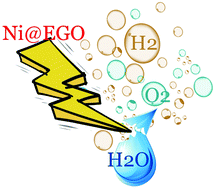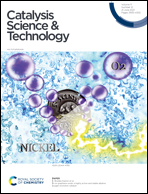Ni on graphene oxide: a highly active and stable alkaline oxygen evolution catalyst†
Abstract
A novel oxygen evolution (OER) catalyst was prepared by reacting NiCl2·6H2O (Ni precursor) with electrochemically exfoliated graphene oxide (EGO) at mild reaction conditions, where the formation of Ni oxide nanoparticles and their deposition onto EGO occurs simultaneously. The resulting Ni@EGO catalyst was tested for OER in base, where it produced high stability and superior performances. Electron microscopy indicated that Ni@EGO had a uniform morphology, which together with the excellent electronic conductivity of the EGO support, must have contributed to the outstanding OER performance of the catalyst. The Ni@EGO catalyst showed superior OER activity with very low overpotential of 250 mV, which gave rise to the substantial current density of 750 A g−1 at 1.6 V. Upon performing long term exhaustive galvanostatic stability tests at 10 mA cm−2, the Ni@EGO was highly stable and it improved over the course of the polarization. During performance studies, significant morphological changes of the material occur within the material as judged by electron microscopy. We believe the notable enhancement of the catalytic activity observed for the system during durability testing could be attributed to electrochemical cleaning of the surface from catalytically inactive nickel aggregates and due to chemical modification of the EGO material by NiOOH species.



 Please wait while we load your content...
Please wait while we load your content...